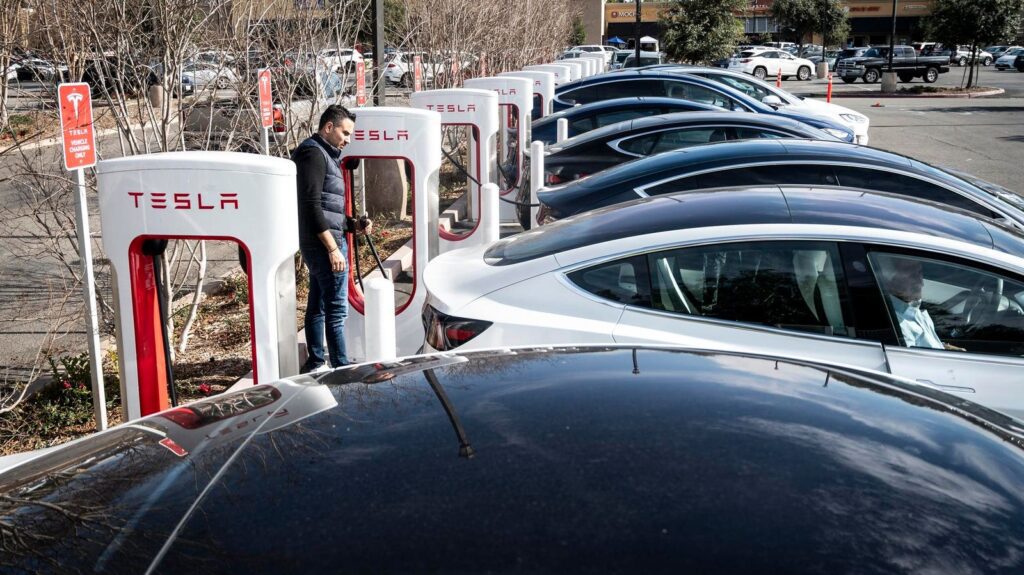Irvine, CA – January 28: Tesla cars charge at a Supercharger station on Culver Ave. in Irvine, CA on … [+] Friday, January 28, 2022. An advisory group in the state legislature is developing recommendations for reusing or recycling electric vehicle batteries. (Photo by Paul Bersebach/MediaNews Group/Orange County Register via Getty Images)
MediaNews Group via Getty Images
A study released this week by the United States Geological Survey (USGS) finds the Smackover formation in Southern Arkansas may contain between 5 million and 19 million tons of lithium, a key element in lithium-ion batteries for electric vehicles and other renewable energy applications. If proven and produced, that would amount to at least 9 times the projected global demand for lithium through the year 2030.
Though some media outlets reported that the USGS and Arkansas government had “found” the massive lithium deposit, the reality is that the Smackover has been known for decades to contain lithium, thanks to drilling companies that have long produced oil and natural gas from the same formation.
ExxonMobil’s Lithium Plans
Forbes readers were informed of the Smackover’s lithium potential in a story last November which detailed plans by ExxonMobil, America’s largest oil company, to also become one of the country’s biggest lithium producers by mounting an ambitious drilling program into the Smackover. In June of this year, ExxonMobil entered into an MOU with SK On, a global EV battery maker, for a multiyear offtake agreement of up to 100,000 metric tons of lithium from the Smackover project. In its release, the company restated its goal of “supplying lithium for about 1 million EV batteries annually by 2030 and support the build out of a U.S. EV supply chain.”
ExxonMobil’s process for recovering the lithium will involve the drilling of a series of wells using drilling rigs similar to oil rigs into the formation, which is roughly 10,000 feet below the surface. The lithium in the Smackover is contained in saltwater, which will flow up the wells to the surface, and then be recovered using a direct lithium extraction (DLE) technology.
The DLE process will be able to extract up to 90% of the lithium resource, which compares to roughly 50% recovered through the traditional process of using enormous evaporation surface ponds. After the metal has been removed, the remaining brine will then be reinjected back into the Smackover formation. ExxonMobil pointed out in its release last November that this process creates less emissions and uses less land than hard rock mining.
Technology is Key to Lithium Recovery
What is new in the USGS report is that this is the first official estimate of the total recoverable lithium resource in place conducted by the U.S. government. This is a function the USGS has traditionally undertaken when it receives information related to discoveries of major new domestic mineral resources.
Where oil and gas are concerned, these initial resource estimates have tended to dramatically underestimate the true level of recoverable resource underground. As an example, the initial USGS assessment of recoverable oil resource in the massive Eagle Ford Shale formation in South Texas was about 4 billion barrels. But, as exploration has progressed and technology has advanced over the last 15 years, the industry has proven many times that volume of recoverable oil reserves.
Technology also advances and becomes more effective and efficient over time as it relates to lithium and other critical energy minerals, so it is possible this initial resource estimate could be revised upwards in future years. But the magnitude of this initial estimate means the Smackover lithium can be considered now to be a key energy security resource.
“The potential for increased U.S. production to replace imports has implications for employment, manufacturing and supply chain resilience,” David Applegate, the director of the United States Geological Survey, said in a statement announcing the study. “This study illustrates the value of science in addressing economically important issues.”
NANTONG, CHINA – APRIL 12, 2023 – Workers rush to make lithium battery products for domestic and … [+] international markets in Nantong, Jiangsu province, China, April 12, 2023. (Photo credit should read CFOTO/Future Publishing via Getty Images)
Future Publishing via Getty Images
Katherine Knierim, confirmed this was a first-time estimate of Arkansas lithium reserves. “Our research was able to estimate total lithium present in the southwestern portion of the Smackover in Arkansas for the first time,” Kirrium said. “We estimate there is enough dissolved lithium present in that region to replace U.S. imports of lithium and more.” She also pointed out that this study “did not estimate the technically recoverable amount based on new and evolving extraction methods.”
The potential for the Smackover to replace U.S. imports of lithium could help meet the stated objective of the Biden/Harris administration to free supply chains of minerals that are central to the success of electric vehicles and renewable energy from their current dominance by China.
The Bottom Line
From ExxonMobil’s perspective, Dan Amman, President of the company’s Low Carbon Solutions unit, said its Smackover plans represent “a perfect example of how ExxonMobil can enhance North American energy security, expand supplies of a critical industrial material, and enable the continued reduction of emissions associated with transportation, which is essential to meeting society’s net-zero goals.”
Amman added that he sees the project as “a win-win-win.” The magnitude of the lithium resource confirmed by the USGS certainly appears to support that assessment.
Source link : http://www.bing.com/news/apiclick.aspx?ref=FexRss&aid=&tid=671adec9a0c5427d98a83f365954b55e&url=https%3A%2F%2Fwww.forbes.com%2Fsites%2Fdavidblackmon%2F2024%2F10%2F24%2Fnew-study-confirms-huge-us-lithium-reserve9-times-global-demand%2F&c=15042467062753255403&mkt=en-us
Author :
Publish date : 2024-10-24 02:21:00
Copyright for syndicated content belongs to the linked Source.
